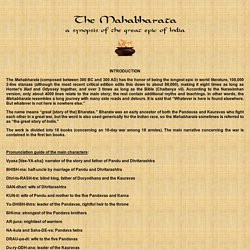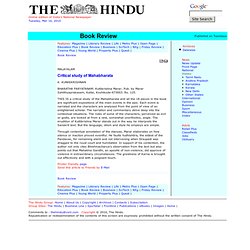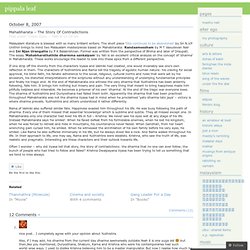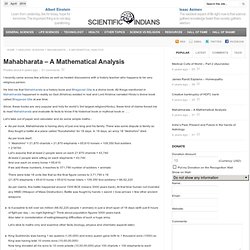

Mahabharata: complete synopsis and notes. The Mahabharata (composed between 300 BC and 300 AD) has the honor of being the longest epic in world literature, 100,000 2-line stanzas (although the most recent critical edition edits this down to about 88,000), making it eight times as long as Homer's Iliad and Odyssey together, and over 3 times as long as the Bible (Chaitanya vii).

According to the Narasimhan version, only about 4000 lines relate to the main story; the rest contain additional myths and teachings. In other words, the Mahabharata resembles a long journey with many side roads and detours. It is said that “Whatever is here is found elsewhere. But whatever is not here is nowhere else.” The name means “great [story of the] Bharatas.” The work is divided into 18 books (concerning an 18-day war among 18 armies). Pronunciation guide of the main characters: Vyasa [Vee-YA-sha]: narrator of the story and father of Pandu and Dhritarashtra BHISH-ma: half-uncle by marriage of Pandu and Dhritarashtra GAN-dhari: wife of Dhritarashtra. Book Review / Language Books : Critical study of Mahabharata. Book Review Critical study of Mahabharata BHARATHA PARYATANAM: Kuttikrishna Marar; Pub. by Marar Sahithyaprakasam, Kallai, Kozhikode-673003.

Rs. 125. THIS IS a critical study of the Mahabharata and all the 18 pieces in the book are significant expositions of the main events in the epic. Each event is narrated and the characters are analysed from the point of view of an enlightened scholar. Through contextual annotation of the stanzas, Marar elaborates on how silence or inaction proved eventful. Printer friendly page Send this article to Friends by E-Mail Book Review. 2 Literary Criticism. Mahabharata – The story of contradictions.
Mahabharata – The story of contradictions Malayalam literature is blessed with so many brilliant writers.

The short piece ‘Sita continues to be abandoned’ by Sri N.V.P Unithiri brings to mind two Malayalam masterpieces based on Mahabharata: Randaamoozham by M T Vasudevan Nair and Ini Njan Urangatte by P K Balakrishnan. Former was written from the perspective of Bhima and later of Draupati. The essay ‘Mahabharathathile dharmma sankalpam’ by Yati is an excellent critical analysis on the concept of ‘dharma’ in Mahabharata. These works encourage the reader to look into these epics from a different perspective. If one strip off the divinity from the characters Vyasa and Valmiki had created, one would invariably see one’s own reflection in them. Rama of Valmiki also suffered similar fate. Often I wonder – why did Vyasa tell that story, the story of contradictions: the dharma that no one can ever follow, the bunch of people who had tried to follow and failed?
Like this: Mahabharata – A Mathematical Analysis. I recently came across few articles as well as heated discussions with a history teacher who happens to be very religious person.

He told me that Mahabharata is a history book and Bhagavad Gita is a divine book. All things mentioned in Mahabharata happened in reality so God (Krishna) existed in real and Lord Krishna narrated Hindu’s divine book called Bhagavad Gita at war time. Since, these books are very popular and holy for world’s 3rd largest religion(Hindu), these kind of claims forced me to read Mahabharata and evaluate its facts to know if its historical book or mythical book or ….. As per book, Mahabharata is having story of just one king and his family. There was some dispute is family so they fought a battle at a place called “Kurukshetra” for 18 days. So finally each priest got 1 son + 100 chariots + 100 elephants, which means10,00,00,000 x 100 = Ten Billion Elephants possible 3000 years back?
The above was pure mathematical analysis. The Mahabharata A Criticism : C. V. Vaidya. Hindu literature : Comprising The Book of good counsels, Nala and Damayanti, The.